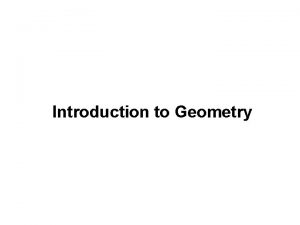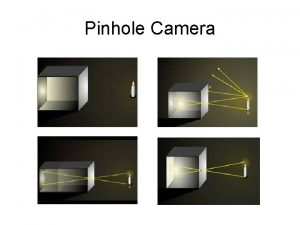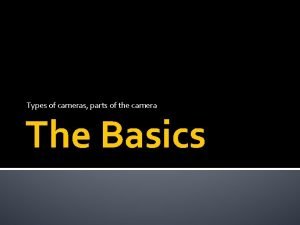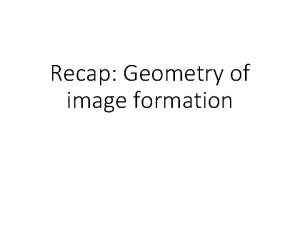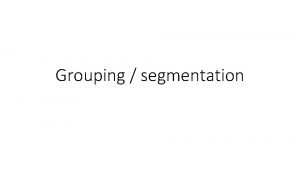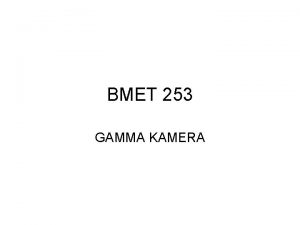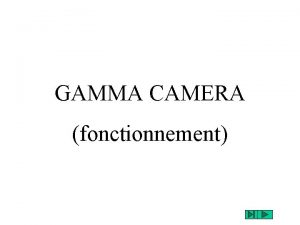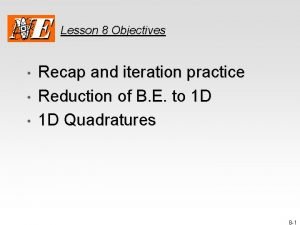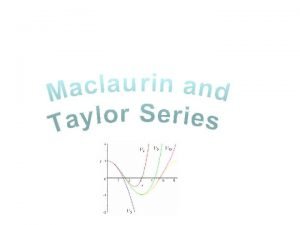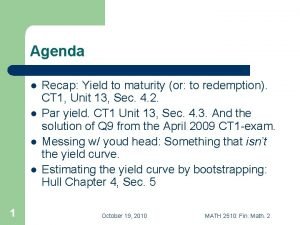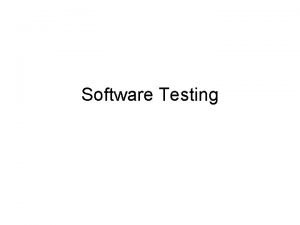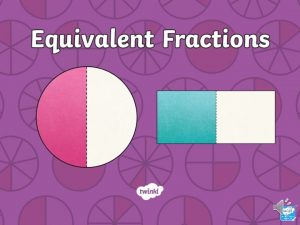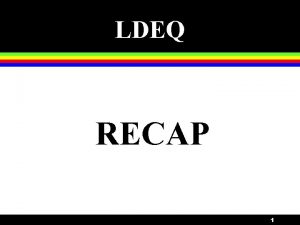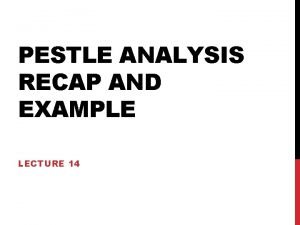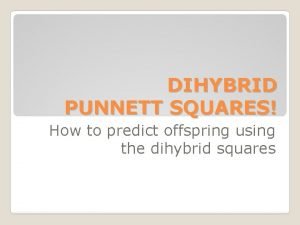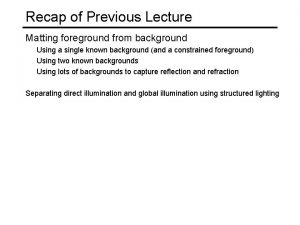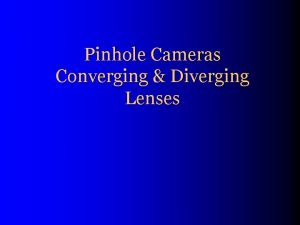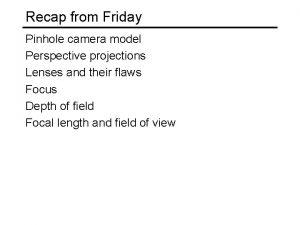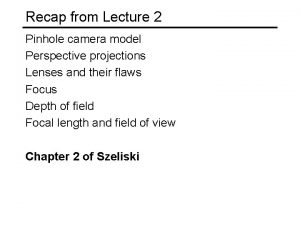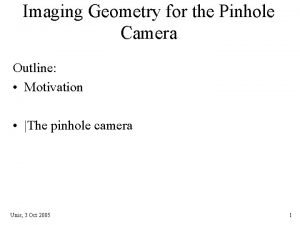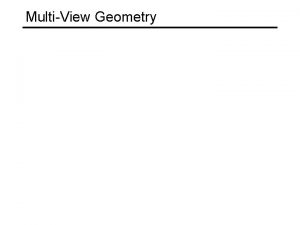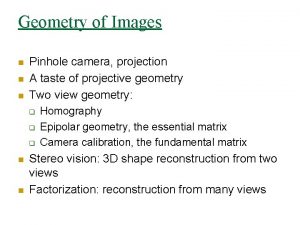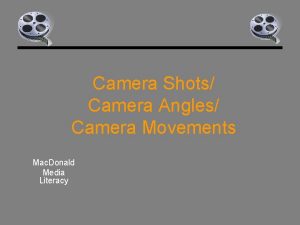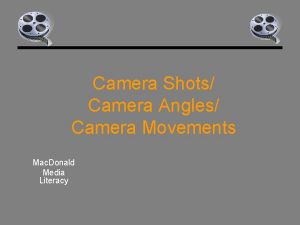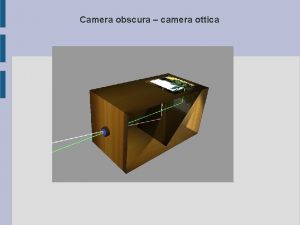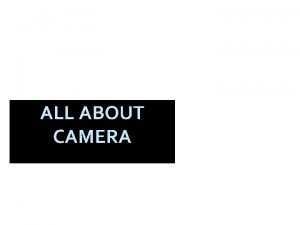Recap Geometry of image formation The pinhole camera




























































- Slides: 60

Recap: Geometry of image formation

The pinhole camera Let’s get into the math

Another derivation P= (X, Y, Z) Y O Z 1 y p= (x, y, z)

A virtual image plane • A pinhole camera produces an inverted image • Imagine a ”virtual image plane” in the front of the camera P P Y Y 1 Z O y 1 y Z O

The projection equation

Consequence 1: Farther away objects are smaller (X, Y + h, Z) (X, Y, Z) Image of foot: Image of head:

Consequence 2: Parallel lines converge at a point

What about planes? Normal: (NX, NY, NZ) What do parallel planes look like? Vanishing lines Parallel planes converge!

Changing coordinate systems Y Y P = (X, Y, Z) O Z O’ Z X X

Putting everything together • Change coordinate system so that center of the coordinate system is at pinhole and Z axis is along viewing direction • Perspective projection

Can projection be represented as a matrix multiplication? Matrix multiplication Perspective projection

The space of rays • (x, y, 1) O

Projective space and homogenous coordinates • Mapping to (points to rays): • Mapping to (rays to points): • A change of coordinates • Also called homogenous coordinates

Homogenous coordinates • In standard Euclidean coordinates • 2 D points : (x, y) • 3 D points : (x, y, z) • In homogenous coordinates • 2 D points : (x, y, 1) • 3 D points : (x, y, z, 1)

Why homogenous coordinates? Homogenous coordinates of world point Homogenous coordinates of image point

Homogenous coordinates

Perspective projection in homogenous coordinates

Matrix transformations in 2 D Scaling of Image x and y (conversion from “meters” to “pixels”) Translation Added skew if image x and y axes are not perpendicular

Final perspective projection Camera extrinsics: where your camera is relative to the world. Changes if you move the camera Camera intrinsics: how your camera handles pixel. Changes if you change your camera

Final perspective projection Camera parameters

Image Formation - Color

The pinhole camera We know where a pixel comes from. But what is its color?

The pinhole camera We know where a pixel comes from. But what is its color? • A pixel is some kind of sensor that measures incident energy • But what exactly does it measure?

Sensing light • Consider a sensor placed in a single beam of light. • How much energy does it get? • Not enough information

Factor 1: Area • Larger sensors capture more power • Power = LA? • L: measure of beam brightness (radiance) • Radiance is power per unit area? A larger sensor captures more energy

Factor 2: Orientation •

Multiple beams •

A hemisphere of directions • In 2 D, direction = angle • Infinitesimal set of directions = infinitesimal angle • Integrate over all directions = integrate over angle • 3 D?

A hemisphere of directions •

Multiple beams •

Integrating over area •

Radiance •

What do pixels measure? •

What do pixels measure? • Radiance of this point in this direction =L

Radiance • Pixels measure radiance This pixel Measures radiance in this direction

Where do the rays come from? • Rays from the light source “reflect” off a surface and reach camera • Reflection: Surface absorbs light energy and radiates it back

Light rays interacting with a surface • I N O

Light rays interacting with a surface • I N O

Light rays interacting with a Incoming energy surface (Irradiance) I N O BRDF: Bidirectional reflectance function

Light rays interacting with a surface I • N O

Light rays interacting with a surface I • N O

Lambertian surface •

Intrinsic image decomposition • Image ”Reflectance” image “Shading” Image

Intrinsic image decomposition • Image ”Reflectance” image “Shading” Image

Integrating over incoming light • General case • Lambertian case

Extension to color • General case • Lambertian case

Intrinsic image decomposition Image “Reflectance” image, depends on paint only “Shading” image depends on shape, lighting

Lambertian surfaces

Far Lambertian surfaces Near shape / depth Reflectance Shading image of Z and L Lambertian reflectance illumination

Other lighting effects

How to create an image • Create objects • Pick shape • Pick material • Is it Lambertian? • Pick albedo • Place objects in coordinate system • Place lights • Place camera • Take image

The final output: image • A grid (matrix) of intensity values 255 255 255 255 255 255 = 255 255 20 0 255 255 255 75 75 75 255 255 75 95 95 75 255 255 96 127 145 175 255 255 127 145 175 175 255 255 127 145 200 175 95 255 255 255 127 145 200 175 95 47 255 255 127 145 175 127 95 47 255 255 47 255 74 127 127 255 255 74 74 74 95 95 95 74 74 74 255 255 255 255 255 255 255 (common to use one byte per value: 0 = black, 255 = white)

Images as functions • Can think of image as a function, f, from R 2 to R or R M: • Grayscale: f (x, y) gives intensity at position (x, y) • f: [a, b] x [c, d] [0, 255] • Color: f (x, y) = [r(x, y), g(x, y), b(x, y)]

The inherent ambiguity in images • Consequence of perspective projection: Loss of depth information Ames room illusion Image credit: Ian Stannard

The inherent ambiguity in images • Consequence of perspective projection: Loss of depth information

The inherent ambiguity of images • Lambertian scene: • Appearance only depends on the angle between surface normal and lighting direction I N O

The inherent ambiguity of images • Bas-relief ambiguity: many surface normal and light directions give same image Belhumeur, Peter N. , David J. Kriegman, and Alan L. Yuille. "The bas-relief ambiguity. " International journal of computer vision 35. 1 (1999): 33 -44.

The inherent ambiguity of images • Raised spots, light from right? • Depressed spots, light from left?

The inherent ambiguity of images • What color is the dress?

The inherent ambiguity of images • Key issue: color can be because of albedo or light https: //xkcd. com/1492/
 Pinhole camera model
Pinhole camera model Explain reflection
Explain reflection Construction of pinhole camera
Construction of pinhole camera Pinhole camera advantages and disadvantages
Pinhole camera advantages and disadvantages Camera science project
Camera science project Pinhole camera effect
Pinhole camera effect Pinhole camera for solar eclipse
Pinhole camera for solar eclipse Jacobs cameras
Jacobs cameras Geometry of image formation
Geometry of image formation Image geometry in digital image processing
Image geometry in digital image processing Maketform
Maketform Fundamental steps in digital image processing
Fundamental steps in digital image processing What is single camera production
What is single camera production Single camera vs multi camera
Single camera vs multi camera Pinhole principle
Pinhole principle Pinhole preparation
Pinhole preparation Back pressure porosity
Back pressure porosity Fungsi bahagian kamera pinhole
Fungsi bahagian kamera pinhole Sir david brewster pinhole photography
Sir david brewster pinhole photography Segmentation
Segmentation Gama kamera çalışma prensibi
Gama kamera çalışma prensibi Collimateur pinhole
Collimateur pinhole Lewis structure of pf3
Lewis structure of pf3 4 electron domains 2 lone pairs
4 electron domains 2 lone pairs The basis of the vsepr model of molecular bonding is _____.
The basis of the vsepr model of molecular bonding is _____. Formation initiale vs formation continue
Formation initiale vs formation continue Gamma camera images
Gamma camera images Shawshank redemption recap
Shawshank redemption recap Chapter eight the great gatsby
Chapter eight the great gatsby What is price matching
What is price matching What is the purpose of an iteration recap
What is the purpose of an iteration recap Recap intensity clipping
Recap intensity clipping 60 minutes recap
60 minutes recap Recap database
Recap database Bracket power rule
Bracket power rule Sample script for recapitulation
Sample script for recapitulation Recap introduction
Recap introduction Recap from last week
Recap from last week The crucible act 1 socratic seminar questions
The crucible act 1 socratic seminar questions The crucible act 1 recap
The crucible act 1 recap Logbook recap example
Logbook recap example Ytm recap
Ytm recap Black box recap
Black box recap Fractions recap
Fractions recap Recap
Recap -language
-language Recap indexing scans
Recap indexing scans Lets recap
Lets recap Recap poster
Recap poster What is a essay
What is a essay Ldeq recap
Ldeq recap Scene
Scene Recap accounting
Recap accounting Example of recap
Example of recap Let's recap
Let's recap Perfect lesson 7
Perfect lesson 7 Ttrr x ttrr
Ttrr x ttrr Recap background
Recap background Normative ethics
Normative ethics Saw recap
Saw recap Briefly recap
Briefly recap
